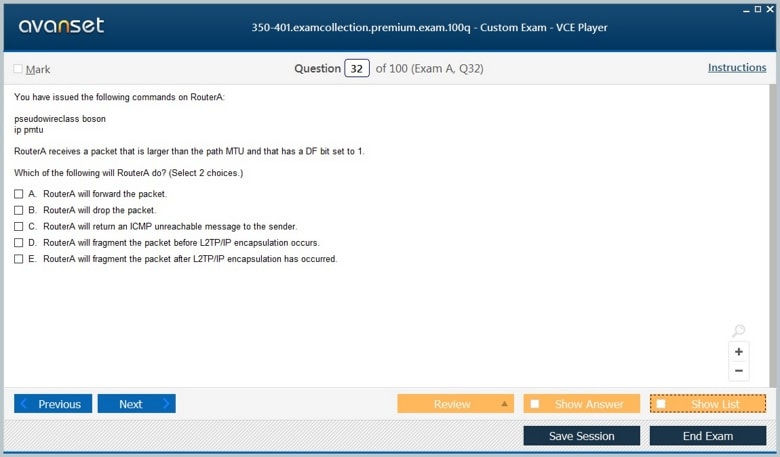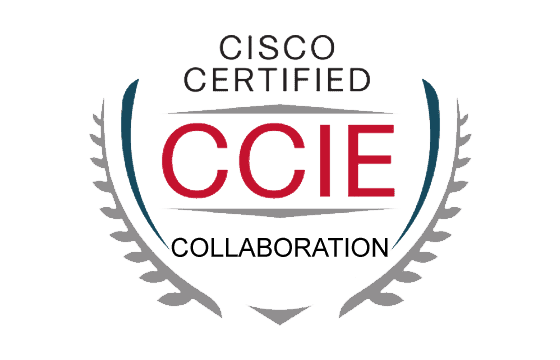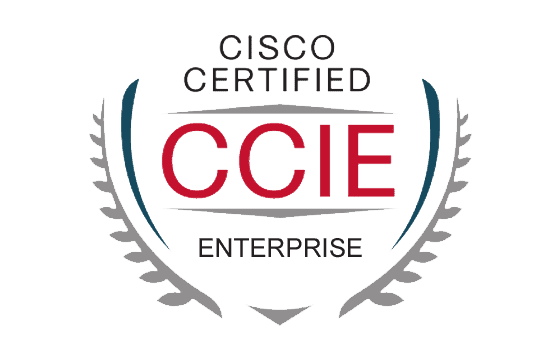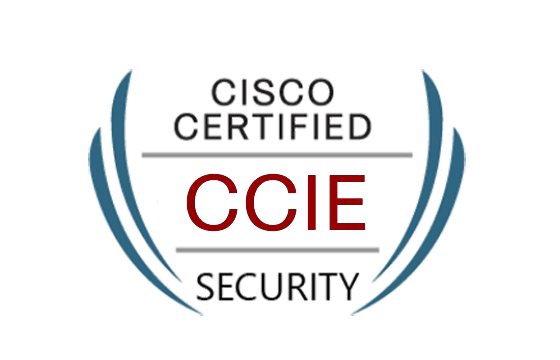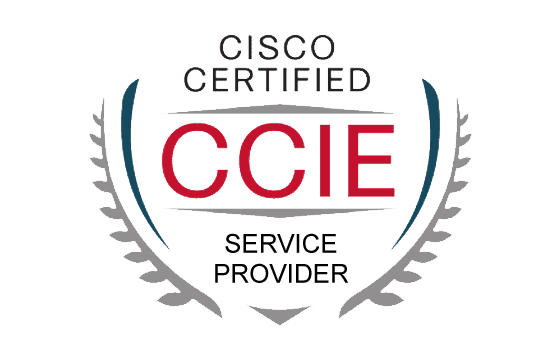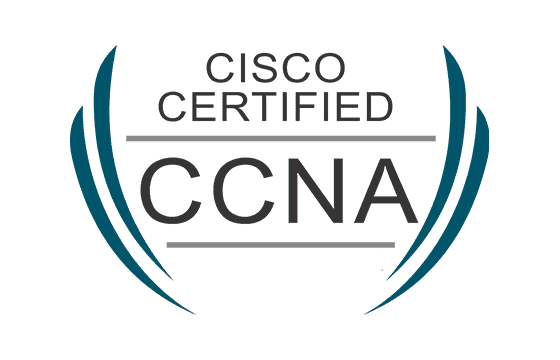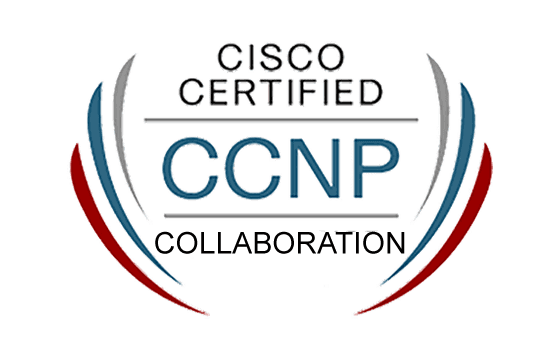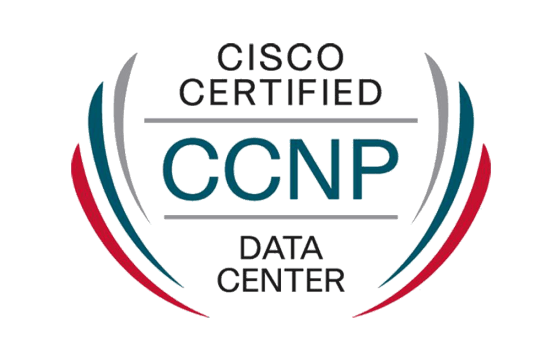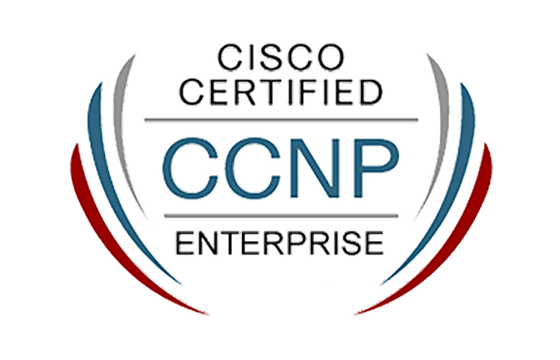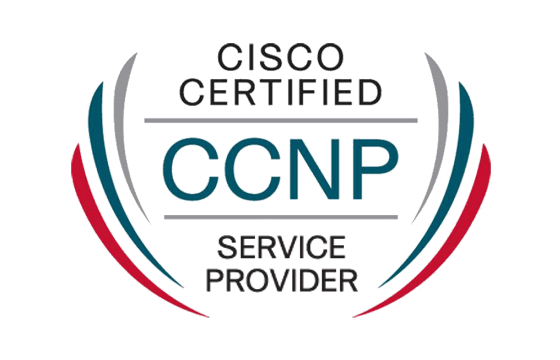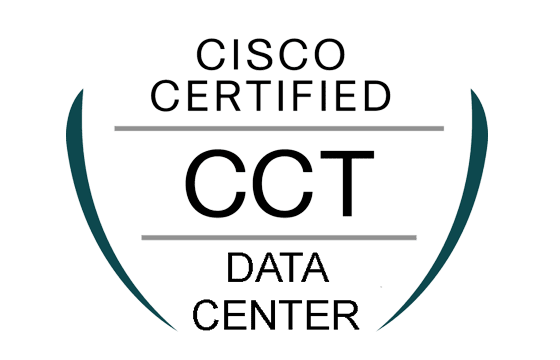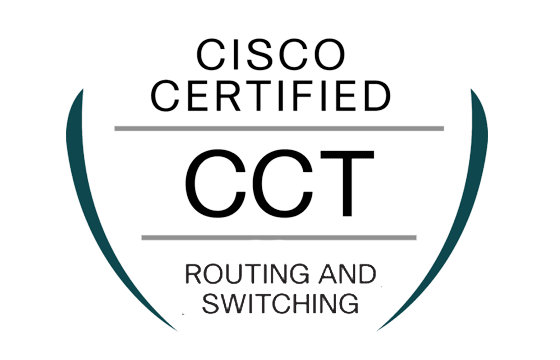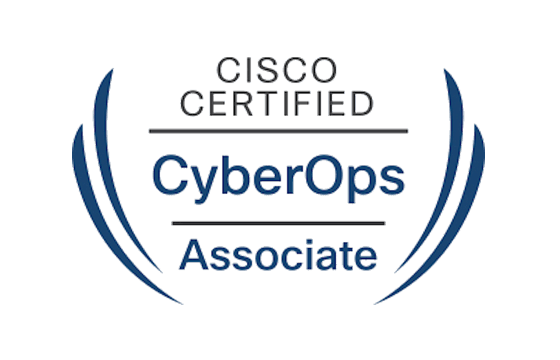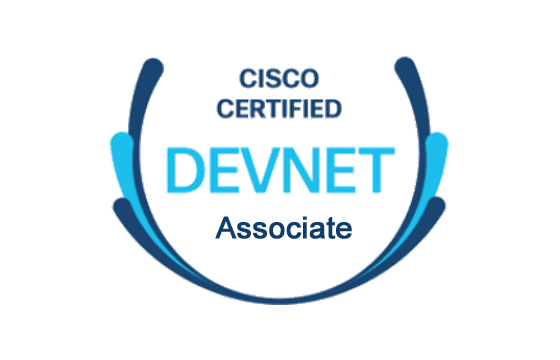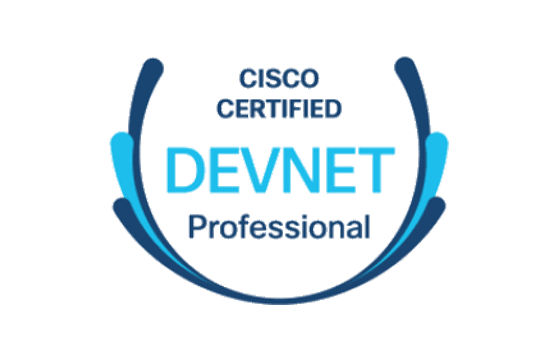Pass Your Cisco CCIE Enterprise Certification Easy!
Cisco CCIE Enterprise Certification Exams Questions & Answers, Accurate & Verified By IT Experts
Instant Download, Free Fast Updates, 99.6% Pass Rate.

Implementing Cisco Enterprise Network Core Technologies (ENCOR)
Includes 728 Questions & Answers
$69.99
Download Free CCIE Enterprise Practice Test Questions VCE Files
| Exam | Title | Files |
|---|---|---|
Exam 350-401 |
Title Implementing Cisco Enterprise Network Core Technologies (ENCOR) |
Files 2 |
Cisco CCIE Enterprise Certification Exam Dumps & Practice Test Questions
Prepare with top-notch Cisco CCIE Enterprise certification practice test questions and answers, vce exam dumps, study guide, video training course from ExamCollection. All Cisco CCIE Enterprise certification exam dumps & practice test questions and answers are uploaded by users who have passed the exam themselves and formatted them into vce file format.
Cisco CCIE Enterprise Infrastructure Unlocked: Expert Strategies, Lab Mastery, and Career Advancement
The Cisco Certified Internetwork Expert (CCIE) Enterprise Infrastructure certification represents one of the highest achievements in networking. Professionals who attain this credential demonstrate an exceptional understanding of enterprise networking technologies, the ability to design and implement complex network solutions, and the expertise to troubleshoot issues at an advanced level. This certification is widely respected in the industry and opens doors to senior roles, including network architect, senior network engineer, and technical lead positions.
Earning the CCIE Enterprise Infrastructure credential is not merely about passing exams; it is about mastering both theoretical knowledge and practical application. The certification covers advanced networking topics including routing, switching, security, automation, and infrastructure management. Candidates are expected to handle real-world scenarios, configure devices under pressure, and provide innovative solutions to networking challenges.
Understanding the Certification Scope
The CCIE Enterprise Infrastructure track focuses on multiple layers of networking technologies. It examines a candidate's ability to manage enterprise-grade networks, implement automation strategies, ensure secure communications, and optimize network performance. The certification validates expertise in both operational and design aspects of networking. Professionals with this credential are prepared to manage large-scale networks efficiently while maintaining security and reliability.
This certification is divided into two main assessments: a written exam and a hands-on lab exam. The written exam evaluates knowledge across routing and switching, network architecture, security concepts, and troubleshooting methodologies. The lab exam tests real-world skills, requiring candidates to configure and troubleshoot complex networks under time constraints.
Written Exam Overview
The written component serves as a foundation for the lab exam. It tests a candidate's understanding of networking principles, theoretical knowledge, and problem-solving abilities. Topics typically include advanced routing protocols such as OSPF, EIGRP, and BGP, layer 2 and layer 3 network designs, network automation, and security implementations. Candidates must demonstrate an ability to analyze network diagrams, design optimal solutions, and anticipate potential issues.
Time management is critical during the written exam. Candidates should approach questions methodically, ensuring that they fully understand the scenario before providing an answer. Practicing with sample questions, reviewing documentation, and reinforcing concepts through practical exercises can improve performance.
Lab Exam Overview
The lab exam is considered the most challenging portion of the CCIE Enterprise Infrastructure certification. It requires hands-on configuration, troubleshooting, and problem-solving in a controlled, timed environment. Candidates must demonstrate proficiency in setting up enterprise networks, implementing routing and switching solutions, applying security measures, and troubleshooting complex network issues.
Unlike the written exam, the lab focuses on practical skills rather than theoretical knowledge. Candidates must navigate real-world networking scenarios, configure devices correctly, and resolve issues under time pressure. This assessment ensures that CCIE-certified professionals are capable of managing networks effectively in high-stakes environments.
Core Topics Covered
The CCIE Enterprise Infrastructure curriculum covers a wide range of topics, including:
Network infrastructure: Advanced routing protocols, switching technologies, and network topologies.
Network automation: Using programmability tools, scripts, and APIs to manage and monitor network devices.
Security: Implementing access control, network segmentation, and threat mitigation strategies.
Network services: Understanding multicast, WAN, LAN, and QoS services to ensure optimal performance.
Troubleshooting: Diagnosing and resolving issues across complex enterprise networks efficiently.
Mastery of these areas is critical for both exams. Candidates are encouraged to approach each domain with hands-on experience, focusing on real-world implementation rather than rote memorization.
Building a Study Plan
Achieving CCIE certification requires a strategic approach to study and preparation. Candidates should create a structured plan that combines theoretical study, hands-on practice, and regular self-assessment. Breaking down the syllabus into manageable sections allows for consistent progress and prevents overwhelm.
Start by reviewing core networking concepts, including TCP/IP, routing and switching fundamentals, and network design principles. Gradually move toward more advanced topics such as automation, security, and complex troubleshooting. Hands-on labs should be incorporated early, enabling candidates to apply theoretical knowledge in practical scenarios.
Consistency is key. Daily practice, review sessions, and scheduled assessments help reinforce learning. Tracking progress and identifying weak areas allows candidates to adjust their study plan accordingly.
Practical Hands-On Experience
Hands-on experience is a cornerstone of CCIE preparation. Candidates should use lab environments, simulators, and real devices to gain practical knowledge. Configuring routers and switches, implementing security protocols, and troubleshooting issues in a controlled environment builds confidence and competence.
Practical experience also helps candidates understand the nuances of network behavior. Observing how routing protocols interact, testing failover scenarios, and simulating network congestion provides valuable insights that cannot be gained from reading alone. Regular practice in realistic scenarios ensures readiness for the lab exam.
Network Design Principles
Understanding network design is critical for CCIE candidates. Enterprise networks must balance performance, security, scalability, and reliability. Professionals should be familiar with hierarchical network design, redundancy strategies, traffic optimization, and fault tolerance mechanisms.
Design principles include:
Segmenting networks to improve security and manage traffic effectively.
Implementing high-availability solutions to minimize downtime.
Using efficient routing protocols to optimize data flow.
Planning for future scalability and technology integration.
By mastering these principles, candidates demonstrate the ability to create networks that meet business requirements while maintaining technical excellence.
Automation and Network Programmability
Modern enterprise networks increasingly rely on automation to streamline operations and reduce human error. CCIE candidates are expected to understand network programmability, including the use of APIs, scripting, and automation tools.
Automation enables efficient device configuration, monitoring, and management. Professionals should be familiar with tools such as Ansible, Python scripting, and network management platforms. Understanding how to automate repetitive tasks allows network engineers to focus on strategic initiatives and complex problem-solving.
Security Implementation
Security is an integral part of enterprise infrastructure. CCIE-certified professionals must implement measures to protect network integrity, confidentiality, and availability. Security topics include access control, firewalls, VPNs, and threat mitigation.
Candidates should understand how to design secure network topologies, segment sensitive areas, and enforce policies to prevent unauthorized access. Regularly practicing security configurations and troubleshooting helps ensure that networks remain resilient against evolving threats.
Troubleshooting Techniques
Effective troubleshooting separates competent engineers from experts. CCIE candidates must diagnose and resolve issues efficiently, often under time constraints. Troubleshooting involves analyzing network behavior, identifying root causes, and applying corrective measures.
Key troubleshooting strategies include:
Systematic analysis: Following structured steps to isolate the problem.
Using diagnostic tools: Leveraging network monitoring, logging, and testing utilities.
Scenario-based practice: Simulating common network failures to build experience.
Continuous learning: Studying past incidents and emerging technologies to anticipate problems.
Developing these skills ensures candidates can maintain network reliability in any enterprise environment.
Preparing for Exam Day
Preparation extends beyond knowledge and practice; it also involves mental readiness. Exam candidates should simulate test conditions, including timed lab sessions and pressure scenarios. Managing stress, pacing tasks, and maintaining focus are critical for success.
Candidates should ensure that they are comfortable with their lab setup, understand the exam layout, and have a strategy for prioritizing tasks. Familiarity with the exam environment reduces anxiety and allows candidates to perform at their best.
Leveraging Resources
Various resources can enhance CCIE preparation. Official Cisco documentation, study guides, lab workbooks, and practice exams provide valuable guidance. Engaging with online communities, discussion forums, and study groups allows candidates to exchange insights and learn from experienced professionals.
It is important to focus on quality resources rather than overwhelming quantity. Structured study materials, real-world practice, and guidance from experts create a balanced preparation strategy that maximizes learning outcomes.
Maintaining Skills Post-Certification
Earning the CCIE certification is a significant achievement, but maintaining expertise requires continuous learning. Networking technologies evolve rapidly, and professionals must stay updated on emerging trends, protocols, and tools.
Post-certification activities include:
Participating in professional development courses.
Attending networking conferences and workshops.
Engaging with the networking community through forums and collaborations.
Practicing lab scenarios to reinforce knowledge and skills.
Continuous improvement ensures that CCIE-certified professionals remain at the forefront of enterprise networking.
Career Impact of CCIE Certification
The CCIE Enterprise Infrastructure certification opens doors to advanced career opportunities. Employers value the expertise, problem-solving ability, and leadership potential of CCIE-certified professionals. Common career paths include:
Senior network engineer
Network architect
Enterprise network consultant
Technical lead in IT infrastructure teams
Beyond career advancement, the CCIE credential also offers higher earning potential and professional recognition. It signals to employers and peers that a professional has mastered complex networking concepts and can contribute significantly to organizational success.
Achieving the Cisco CCIE Enterprise Infrastructure certification is a challenging but rewarding journey. Success requires dedication, structured study, practical experience, and continuous learning. Candidates who invest time in understanding advanced network concepts, mastering hands-on skills, and developing problem-solving strategies are well-positioned to excel in both the written and lab exams.
This certification not only validates technical expertise but also enhances career prospects and professional credibility. By following a strategic preparation plan, leveraging resources, and engaging in hands-on practice, aspiring network experts can confidently navigate the path to CCIE success.
Advanced Routing Protocols in Enterprise Networks
Routing is a cornerstone of enterprise network infrastructure, and mastery of advanced routing protocols is essential for CCIE Enterprise Infrastructure candidates. Protocols such as OSPF, EIGRP, and BGP form the backbone of modern networks. Understanding their behavior, configuration, and optimization is critical to designing scalable and reliable enterprise networks.
OSPF, a link-state protocol, allows for efficient routing within large networks by maintaining a comprehensive map of the network topology. Candidates should understand concepts such as areas, LSAs, and route summarization. Implementing OSPF effectively ensures optimal path selection and fast convergence in case of failures.
EIGRP, a hybrid routing protocol, combines the benefits of distance-vector and link-state protocols. CCIE candidates must be familiar with its metrics, neighbor relationships, and route advertisement behavior. Proper configuration of EIGRP enhances network stability and performance in multi-router environments.
BGP, the protocol of choice for large-scale enterprise and service provider networks, requires in-depth knowledge of path selection, attributes, and policy implementation. Understanding BGP is critical for scenarios involving multiple WAN connections, redundancy, and internet-facing services.
Switching Technologies and Network Topologies
Switching forms the foundation of enterprise LAN design. Advanced switching knowledge is essential for network segmentation, traffic management, and high availability. Concepts such as VLANs, trunking, spanning tree protocols, and EtherChannel configurations are critical for creating robust networks.
VLANs enable logical segmentation of the network, improving security and performance. Candidates should practice designing VLAN hierarchies, configuring inter-VLAN routing, and optimizing traffic flow. Understanding VLAN behavior across multiple switches ensures a seamless enterprise network design.
Spanning Tree Protocols (STP) and its variants prevent loops in switched networks. Advanced candidates should be familiar with Rapid PVST+, MST, and configuring port priorities to influence path selection. EtherChannel allows link aggregation, increasing bandwidth and providing redundancy. Correctly configuring these features ensures network efficiency and resilience.
Enterprise Network Security
Security is integral to enterprise network infrastructure. Candidates must understand how to implement robust security measures at multiple layers of the network. Access control lists (ACLs), firewall integration, VPNs, and segmentation strategies are essential tools for protecting sensitive data.
Properly configured ACLs regulate traffic flow, preventing unauthorized access while ensuring essential services remain operational. Firewalls enforce policies and provide a defensive barrier against external threats. VPNs secure communication across WANs and remote networks, ensuring confidentiality and integrity of data transmissions.
Network segmentation, combined with role-based access and monitoring, helps mitigate potential threats. Security best practices include continuous monitoring, implementing redundancy, and maintaining updated configurations to address evolving vulnerabilities.
Network Services and Optimization
Enterprise networks rely on various services to maintain performance and reliability. Quality of Service (QoS), multicast, and WAN optimization are vital for ensuring efficient communication across complex networks.
QoS enables prioritization of critical traffic such as voice and video, reducing latency and jitter. Understanding classification, marking, queuing, and scheduling mechanisms allows engineers to optimize network performance.
Multicast is essential for applications like video conferencing, IPTV, and software updates. Configuring multicast routing protocols, such as PIM-Sparse Mode or PIM-Dense Mode, ensures efficient delivery without overloading the network. WAN optimization techniques, including traffic shaping and compression, enhance user experience and reduce costs.
Automation and Network Programmability
Modern networks increasingly incorporate automation to simplify management and reduce operational complexity. CCIE candidates are expected to understand programmability concepts, including API integration, scripting, and orchestration tools.
Automation allows for consistent configurations, faster deployments, and reduced human error. Familiarity with tools such as Ansible, Python scripting, and network management frameworks is crucial for managing dynamic networks effectively.
Candidates should practice automating common tasks such as device provisioning, configuration backup, and monitoring. Understanding automation workflows ensures that engineers can scale networks efficiently and respond rapidly to changes or incidents.
Troubleshooting Methodologies
Advanced troubleshooting is a defining skill for CCIE professionals. Diagnosing network issues requires a structured approach, analytical thinking, and practical experience. Candidates should develop a methodology that includes problem identification, hypothesis formulation, testing, and resolution.
Common troubleshooting scenarios include routing loops, configuration errors, latency issues, and service outages. Using tools like ping, traceroute, logging, and packet captures helps identify the root cause efficiently. Scenario-based practice is essential to develop confidence in resolving complex problems under time pressure.
Proactive troubleshooting, including monitoring network health and analyzing trends, minimizes downtime and ensures smooth network operations. Engineers should document resolutions and maintain knowledge bases to improve efficiency and prevent recurring issues.
High Availability and Redundancy
Ensuring network availability is critical for enterprise operations. Redundancy mechanisms, failover protocols, and disaster recovery planning are essential for maintaining uninterrupted services.
High availability strategies include configuring redundant links, implementing VRRP or HSRP for gateway redundancy, and deploying load-balancing mechanisms. Candidates should understand how to design networks that tolerate failures without significant service disruption.
Disaster recovery planning involves identifying critical services, creating recovery procedures, and testing failover processes. By preparing for potential failures, network engineers minimize downtime and maintain business continuity.
Advanced IP Services
Enterprise networks rely on IP services such as NAT, DHCP, DNS, and IP multicast for proper functioning. CCIE candidates must configure and optimize these services to support enterprise applications.
NAT enables translation between private and public IP addresses, supporting internet connectivity. DHCP automates IP address assignment, reducing administrative overhead. DNS ensures accurate hostname resolution, critical for both internal and external communication. Proper implementation of these services ensures reliability, security, and performance.
Performance Monitoring and Optimization
Monitoring network performance is critical for maintaining service levels. Engineers should be familiar with tools and techniques to assess bandwidth utilization, latency, packet loss, and network health.
Proactive monitoring enables early detection of potential bottlenecks, allowing for timely corrective actions. Optimization involves tuning configurations, adjusting routing protocols, and implementing QoS policies to ensure efficient traffic flow. Continuous performance assessment ensures networks operate at peak efficiency.
Designing Scalable Networks
Scalability is essential for enterprise networks that grow over time. Engineers must design networks that can accommodate increasing traffic, new applications, and additional users without compromising performance.
Scalable design involves hierarchical network architecture, modular deployment, and redundancy planning. Segmenting networks into manageable units, implementing efficient routing strategies, and preparing for future expansion ensures long-term network sustainability. Candidates should practice designing networks with both current needs and future growth in mind.
Preparing for Complex Lab Scenarios
The CCIE lab exam presents complex, real-world scenarios requiring multiple skills simultaneously. Candidates must configure networks, implement security measures, troubleshoot issues, and optimize performance under time constraints.
Preparing involves extensive hands-on practice, scenario simulation, and time management strategies. Candidates should work through layered scenarios, integrating routing, switching, security, and services to replicate exam conditions. Consistent practice builds the confidence and expertise needed to excel in the lab environment.
Leveraging Study Resources
Effective preparation requires careful selection of study materials. Official guides, lab manuals, video tutorials, and community resources provide valuable insights. Candidates should focus on structured learning paths that combine theory, practice, and problem-solving.
Engaging with study groups and forums allows knowledge sharing and exposure to diverse approaches. Mentorship from experienced CCIE professionals can provide guidance, reduce mistakes, and improve efficiency in preparation.
Exam Day Strategies
Success in the CCIE exam relies on both knowledge and strategy. Candidates should develop a plan for approaching questions, managing time, and prioritizing tasks. Practicing full lab simulations under timed conditions builds endurance and familiarity.
Remaining calm, analyzing scenarios carefully, and validating configurations before submission are crucial. Candidates should allocate time to review their work, ensuring all requirements are met and errors are minimized.
Career Advancement Through CCIE
CCIE Enterprise Infrastructure certification significantly enhances career prospects. Professionals gain recognition as experts in enterprise networking, often leading to leadership roles, consulting opportunities, and higher compensation.
Employers value the practical expertise, problem-solving ability, and strategic insight of CCIE-certified professionals. Beyond career advancement, the certification demonstrates a commitment to continuous learning and professional excellence.
Continuous Learning and Skill Maintenance
Networking technologies evolve rapidly, and maintaining CCIE-level skills requires ongoing learning. Professionals should engage in continuous education, attend conferences, participate in webinars, and practice hands-on labs.
Staying updated with emerging technologies, security practices, and automation trends ensures that CCIE-certified engineers remain valuable assets in any organization. Continuous improvement reinforces expertise and prepares professionals for future challenges.
Advanced routing, switching, security, and network services form the foundation of enterprise networking expertise. Mastery of these topics, combined with practical hands-on experience and strategic exam preparation, ensures success in the CCIE Enterprise Infrastructure certification.
By understanding complex protocols, implementing robust designs, and practicing troubleshooting and automation, candidates develop the skills required to manage modern enterprise networks efficiently. Continuous learning and professional development further strengthen a CCIE professional’s career trajectory, establishing them as a recognized expert in the field.
Lab Exam Essentials for CCIE Enterprise Infrastructure
The lab exam is widely regarded as the most challenging component of the CCIE Enterprise Infrastructure certification. It evaluates a candidate’s ability to configure, troubleshoot, and optimize complex enterprise networks in real-world scenarios. Success in this portion of the certification requires extensive hands-on practice, familiarity with devices and commands, and a disciplined approach to time management.
Candidates must demonstrate proficiency in multiple areas simultaneously, including advanced routing, switching, network security, network services, and automation. The exam is designed to test both technical skill and problem-solving ability under pressure.
Structuring Lab Preparation
A systematic approach to lab preparation is critical. Start by dividing the lab syllabus into distinct modules based on exam topics. Focus on mastering one area at a time, such as routing protocols, before integrating multiple areas into comprehensive practice scenarios.
Practice labs should mimic real-world network setups, allowing candidates to configure routers, switches, firewalls, and other network devices. Using both physical and virtual labs ensures familiarity with different environments. Consistency and repetition reinforce learning and build confidence for exam day.
Time Management During the Lab
Time is one of the most significant challenges in the CCIE lab exam. Candidates have a limited window to complete all tasks, so prioritizing and pacing work is essential.
Begin by quickly reviewing the topology and instructions. Identify areas that require immediate attention and separate tasks into high, medium, and low priority. Completing critical routing and switching tasks early ensures a functional network core, leaving additional features and optimizations for later.
Practicing full lab scenarios under timed conditions is the best way to develop speed and accuracy. Track how long each task takes and identify areas where efficiency can be improved.
Routing and Switching Scenarios
The backbone of the CCIE lab consists of routing and switching configurations. Candidates must demonstrate the ability to implement complex routing protocols, optimize paths, and configure switching features effectively.
Routing tasks may include OSPF area design, EIGRP route summarization, BGP path selection, redistribution, and route filtering. Candidates should practice scenarios involving multiple routers and networks to ensure familiarity with configuration and verification commands.
Switching scenarios often involve VLAN configuration, spanning tree optimization, EtherChannel setup, and advanced layer 2 features. Understanding switch behavior under various conditions is critical for preventing loops and ensuring network stability.
Security Configuration in Labs
Security plays a major role in enterprise network design, and the lab exam requires candidates to implement robust security measures. Tasks may include access control lists, VPN setup, firewall integration, and secure device access.
Candidates should understand how to apply security best practices without impacting overall network performance. Configuring ACLs correctly, segmenting sensitive traffic, and verifying secure connectivity ensures that security requirements are met while maintaining functionality.
Network Services and Troubleshooting
The lab exam also tests network services such as QoS, multicast, DHCP, and DNS. Candidates must implement these services and ensure proper operation across the network.
QoS scenarios involve prioritizing critical traffic like voice and video to maintain performance. Multicast configurations ensure efficient delivery of group traffic. DHCP and DNS must be correctly deployed to support dynamic addressing and name resolution.
Troubleshooting is an ongoing component of the lab. Candidates are often required to identify and resolve issues intentionally introduced into the network. Using systematic methods to isolate problems, verify configurations, and correct errors is critical to successfully completing the lab.
Automation and Programmability in Labs
Modern enterprise networks increasingly rely on automation. The lab exam may include tasks related to network programmability, such as scripting configurations, automating repetitive tasks, and using APIs to manage devices.
Candidates should practice creating and deploying automation scripts using tools like Python or Ansible. Understanding how to integrate automation with existing network infrastructure streamlines operations and demonstrates advanced proficiency.
Effective Troubleshooting Techniques
Troubleshooting is not only about fixing errors but also about identifying root causes quickly. Candidates should follow a structured approach:
Verify the problem using diagnostic tools such as ping, traceroute, and logging.
Isolate the issue by segmenting the network or testing components individually.
Apply corrective measures and re-test to ensure resolution.
Document the resolution process for future reference.
Frequent practice with troubleshooting scenarios builds confidence and reduces the time needed to solve problems under exam pressure.
Optimizing Lab Performance
Efficiency in the lab exam comes from combining technical knowledge with strategy. Candidates should:
Memorize essential commands to avoid delays.
Develop a consistent workflow for configuring devices.
Use verification commands frequently to confirm correct configurations.
Keep track of tasks completed and remaining to ensure no requirements are overlooked.
Practicing optimization strategies in lab scenarios increases accuracy and improves performance under time constraints.
Building Confidence with Mock Labs
Mock labs simulate the exam environment, allowing candidates to practice full-scale configurations under timed conditions. These exercises help identify gaps in knowledge, reinforce problem-solving skills, and improve time management.
Candidates should replicate a variety of scenarios, including multi-router topologies, complex VLAN and routing setups, security implementations, and service configurations. Repeated exposure to challenging situations strengthens expertise and builds exam-day confidence.
Handling Exam Pressure
The CCIE lab exam can be stressful due to its complexity and time limitations. Candidates should develop techniques for maintaining focus and composure.
Staying calm, reading instructions carefully, and prioritizing tasks helps prevent errors. Taking brief moments to review configurations and confirm functionality reduces mistakes. Mental preparation, combined with extensive practice, ensures candidates are ready to perform under pressure.
Continuous Knowledge Reinforcement
Even with strong technical skills, continuous reinforcement is necessary to maintain proficiency. Daily practice sessions, scenario simulations, and reviewing documentation help solidify knowledge.
Engaging with peers in study groups or professional communities allows candidates to learn from others’ experiences and gain new perspectives. Regular exposure to diverse scenarios strengthens problem-solving abilities and reinforces best practices.
Exam-Day Readiness Checklist
Preparation extends beyond technical knowledge. Candidates should ensure:
Familiarity with the lab topology and exam tools.
A clear strategy for prioritizing and managing tasks.
Understanding of verification and diagnostic commands.
Confidence in handling time pressure and troubleshooting efficiently.
Having a checklist helps reduce anxiety and ensures nothing is overlooked during the exam.
Integrating Theory and Practice
The most successful candidates combine theoretical understanding with practical experience. Knowing how routing protocols function conceptually is important, but applying them in real-world configurations demonstrates true mastery.
Candidates should connect theory with practice by:
Implementing network designs based on learned concepts.
Testing configurations under various conditions.
Troubleshooting to identify how theory translates into behavior.
This integration ensures readiness for both the written and lab exams.
Maintaining Certification Relevance
After earning CCIE certification, maintaining expertise requires ongoing learning. Networking technologies evolve rapidly, and staying updated is essential.
Activities include:
Practicing with new lab scenarios.
Learning emerging protocols and technologies.
Participating in professional forums, workshops, and webinars.
Continuing hands-on experience in enterprise environments.
Continuous learning reinforces the value of the certification and keeps skills relevant.
Real-World Applications of CCIE Skills
The knowledge and skills gained while preparing for the CCIE exam have immediate applicability in professional environments. Certified professionals can:
Design and implement scalable, reliable networks.
Troubleshoot and resolve complex network issues efficiently.
Optimize network performance for mission-critical applications.
Implement robust security measures to protect enterprise data.
Automate network operations to reduce operational overhead.
These capabilities make CCIE-certified engineers valuable assets in any organization, capable of handling advanced infrastructure challenges.
Career Impact of Lab Proficiency
Mastering the lab exam not only earns certification but also builds confidence and competence for high-level networking roles. Professionals with lab experience are better prepared to handle complex enterprise networks, lead technical teams, and mentor junior engineers.
Employers recognize lab-trained engineers as problem-solvers who can deliver high-quality solutions under pressure. This expertise translates into career growth, higher salaries, and expanded responsibilities.
The CCIE Enterprise Infrastructure lab exam is a rigorous test of knowledge, skill, and strategy. Success requires a structured approach to preparation, extensive hands-on practice, efficient time management, and effective troubleshooting techniques.
Candidates who integrate theoretical knowledge with practical experience, practice under simulated exam conditions, and continuously reinforce their skills are best positioned to excel. Mastery of the lab not only leads to certification but also equips professionals with the advanced expertise needed to thrive in complex enterprise network environments.
Advanced Enterprise Network Design Principles
Designing an enterprise network is a critical skill for CCIE Enterprise Infrastructure professionals. Effective network design ensures scalability, security, reliability, and optimal performance. It requires a deep understanding of both theoretical concepts and real-world application. Advanced network design encompasses hierarchical architecture, redundancy strategies, traffic optimization, and integration of emerging technologies.
Hierarchical network design provides a structured approach, dividing the network into core, distribution, and access layers. Each layer has a specific role, reducing complexity and improving manageability. The core layer focuses on high-speed transport, the distribution layer handles policy enforcement and routing, and the access layer provides connectivity to end devices.
Redundancy and High Availability Strategies
Maintaining network uptime is crucial for enterprise operations. High availability and redundancy ensure that services remain operational even in the event of device or link failures. Techniques include redundant links, multiple paths, load balancing, and gateway redundancy protocols like HSRP and VRRP.
Candidates should understand how to design networks that tolerate failures without service disruption. Implementing redundant links with proper spanning tree configurations prevents loops, while load balancing distributes traffic efficiently across available paths. Gateway redundancy ensures critical devices remain reachable during failures.
WAN Design and Optimization
Enterprise networks often span multiple locations, making WAN design an essential consideration. WANs must balance cost, performance, and reliability. Understanding technologies such as MPLS, VPN, SD-WAN, and WAN optimization is critical for modern enterprise networks.
MPLS networks provide predictable performance and traffic engineering capabilities, while VPNs secure communications across public networks. SD-WAN solutions offer centralized management, path optimization, and application-level awareness. WAN optimization techniques, such as traffic shaping, compression, and caching, enhance performance and reduce latency.
Network Automation and Programmability
Automation is no longer optional in enterprise networks. It enables consistent configurations, faster deployments, and reduced human error. Candidates should be proficient in network programmability, scripting, and orchestration tools.
Python, Ansible, and APIs are commonly used to automate device configuration, backup processes, monitoring, and troubleshooting tasks. Understanding automation workflows and integrating them with existing network infrastructure improves efficiency and scalability.
Candidates should practice automating real-world tasks, such as deploying VLANs across multiple switches, configuring routing protocols programmatically, and automating compliance checks. Automation skills are highly valued by employers and are increasingly required for senior network roles.
Security Design and Best Practices
Security is an integral part of enterprise network design. CCIE candidates must ensure that networks are protected against unauthorized access, data breaches, and malicious activity. This includes implementing access controls, firewalls, segmentation, and monitoring solutions.
Network segmentation isolates sensitive resources, reducing the attack surface. Firewalls enforce policy and control traffic flow between segments. Access control lists define permissions, while intrusion detection and prevention systems monitor for threats. Candidates should also consider secure management practices, such as role-based access and encrypted communications.
Security must be integrated into every layer of the network, from access to core. Designing networks with built-in security ensures resilience and compliance with industry standards.
Quality of Service and Traffic Management
Enterprise networks often carry a mix of critical and non-critical traffic. Quality of Service (QoS) ensures that important applications, such as voice and video, receive priority while maintaining overall network performance.
Candidates should understand traffic classification, marking, queuing, and scheduling mechanisms. Implementing QoS policies requires analyzing network traffic patterns, identifying latency-sensitive applications, and configuring devices to enforce priority rules.
Effective traffic management enhances user experience, prevents congestion, and maintains service-level agreements. QoS design should be aligned with enterprise priorities and regularly monitored to adapt to changing requirements.
Advanced Troubleshooting Strategies
Even well-designed networks can encounter issues. Advanced troubleshooting requires systematic analysis, practical experience, and familiarity with diagnostic tools. Candidates should be proficient in using ping, traceroute, packet captures, logs, and monitoring platforms.
Structured troubleshooting involves identifying the symptoms, isolating the problem, testing potential solutions, and verifying results. Documenting resolutions and maintaining knowledge bases helps streamline future troubleshooting efforts.
Scenario-based practice is crucial for developing troubleshooting proficiency. Candidates should work on complex multi-layer issues involving routing, switching, security, and services to simulate real-world challenges.
Integration of Emerging Technologies
Modern enterprise networks increasingly incorporate new technologies, such as cloud services, virtualization, IoT, and software-defined networking (SDN). CCIE candidates should understand how these technologies impact network design, performance, and security.
Cloud integration requires understanding connectivity models, security considerations, and hybrid architectures. Virtualization introduces virtual switches, routers, and firewalls that must be managed alongside physical infrastructure. IoT devices create additional endpoints that require segmentation and monitoring. SDN provides centralized control and dynamic network programmability.
Adapting network design to accommodate emerging technologies ensures long-term relevance and efficiency. Candidates should practice implementing hybrid solutions, automating management, and integrating monitoring tools for comprehensive visibility.
Lab Practice for Advanced Design
Hands-on lab practice is essential for mastering network design concepts. Candidates should simulate large enterprise environments, configuring core, distribution, and access layers with redundancy, QoS, security, and WAN integration.
Mock labs should replicate real-world scenarios, requiring candidates to troubleshoot, optimize, and integrate multiple technologies simultaneously. Consistent lab practice reinforces knowledge, builds confidence, and prepares candidates for the complexity of the CCIE lab exam.
Career Advantages of Advanced Network Design Skills
Proficiency in advanced network design significantly enhances career opportunities. Professionals with strong design capabilities can lead infrastructure projects, optimize operations, and mentor junior engineers. Employers value candidates who can architect scalable, reliable, and secure networks that meet business objectives.
Design expertise also supports career growth into roles such as network architect, enterprise consultant, and senior infrastructure engineer. Organizations rely on these professionals to implement solutions that reduce downtime, improve performance, and enable digital transformation initiatives.
Continuous Learning and Professional Growth
Networking technologies evolve rapidly, and continuous learning is critical to maintaining expertise. Candidates and certified professionals should engage in ongoing education, attend workshops, follow industry trends, and participate in professional communities.
Practicing lab scenarios, testing emerging tools, and exploring new design methodologies ensure that skills remain current. Networking professionals who actively pursue learning opportunities are better positioned to address complex challenges, adopt new technologies, and provide strategic value to their organizations.
Real-World Applications of Design Expertise
The concepts mastered during CCIE preparation have immediate applications in enterprise environments. Professionals apply advanced network design principles to:
Implement scalable, high-performance networks.
Integrate new technologies with minimal disruption.
Optimize resource utilization and traffic flow.
Maintain robust security and compliance.
Enable automation and centralized management.
These capabilities enhance organizational efficiency, improve reliability, and contribute to successful IT initiatives.
Preparing for Leadership Roles
Advanced network design skills also prepare professionals for leadership and strategic roles. Engineers who understand both technical and business requirements can influence network strategy, budget allocation, and project planning.
Leadership roles often involve coordinating teams, mentoring engineers, and ensuring alignment between IT infrastructure and business goals. CCIE-certified professionals with design expertise are well-suited for these responsibilities, providing technical guidance and strategic insight.
Advanced enterprise network design is a critical competency for CCIE Enterprise Infrastructure professionals. Mastery of hierarchical architecture, redundancy, WAN optimization, automation, security, QoS, and emerging technologies ensures networks are scalable, reliable, and efficient.
Hands-on lab practice, continuous learning, and integration of theory with real-world scenarios prepare candidates for both the CCIE lab exam and professional roles. Professionals with advanced design skills can contribute significantly to organizational success, drive innovation, and advance their careers in enterprise networking.
CCIE Enterprise Infrastructure Exam Strategy
Achieving success in the CCIE Enterprise Infrastructure certification requires not only technical expertise but also a well-structured exam strategy. Candidates must prepare for both the written and lab components by combining theoretical knowledge with practical application. Developing a strategic approach to studying, managing time, and handling exam scenarios is crucial for passing this rigorous certification.
An effective exam strategy begins with understanding the exam blueprint. Candidates should identify key domains, allocate study time proportionally, and integrate hands-on practice with theory. Prioritizing areas of weakness and practicing complex scenarios ensures comprehensive preparation.
Structured Study Plan
A structured study plan helps candidates progress efficiently through the CCIE syllabus. Begin with foundational topics, such as TCP/IP, routing protocols, and switching principles, before advancing to complex design, security, and automation topics.
Breaking the syllabus into manageable sections allows for consistent learning and prevents burnout. Daily study routines, focused lab practice, and regular self-assessment improve retention and build confidence. Candidates should also schedule periodic review sessions to reinforce previously learned concepts.
Hands-On Lab Practice
Hands-on lab practice is essential for both skill development and exam readiness. Candidates should simulate enterprise environments, configure routers, switches, firewalls, and test real-world scenarios.
Lab practice should include routing and switching, VLAN and spanning tree configurations, security implementations, QoS and network services, and automation. Mock labs help candidates identify gaps in knowledge, develop troubleshooting skills, and improve time management. Repeated practice builds confidence for the timed lab exam.
Time Management During Exams
Time management is a critical factor in CCIE success. Candidates must balance speed with accuracy to complete tasks within the allotted exam time.
During the written exam, carefully read questions, analyze scenarios, and avoid rushing. Allocate time for reviewing answers and ensuring completeness. For the lab exam, prioritize tasks based on their impact on network functionality. Complete core routing and switching tasks first, followed by security, QoS, and optional services. Consistent time monitoring ensures that all requirements are addressed efficiently.
Troubleshooting Approach
Troubleshooting is a core component of the CCIE lab exam. Candidates should adopt a structured approach, beginning with problem identification, followed by analysis, hypothesis testing, and resolution.
Using diagnostic tools, such as ping, traceroute, and logging, helps isolate issues quickly. Scenario-based practice enhances problem-solving skills and reduces the time required to resolve complex network issues. Documenting the troubleshooting process and applying lessons learned improves long-term expertise.
Exam-Day Preparation
Preparing mentally and physically for exam day is as important as technical preparation. Candidates should ensure familiarity with the exam environment, tools, and procedures.
Adequate rest, nutrition, and stress management are essential for maintaining focus and stamina during the lab exam. Practicing under simulated exam conditions helps candidates build confidence, refine workflows, and adapt to the time constraints and pressure of the actual test.
Leveraging Study Resources
Accessing high-quality study resources is key to efficient preparation. Candidates should utilize official Cisco guides, lab manuals, video tutorials, and online communities.
Engaging with study groups or mentors provides additional insights, alternative approaches, and moral support. Quality over quantity is crucial; structured materials that combine theory with practical exercises ensure comprehensive learning. Candidates should focus on resources that reinforce understanding rather than memorization.
Networking and Professional Communities
Participation in professional communities enhances learning and career growth. Networking with peers, instructors, and industry experts exposes candidates to diverse scenarios, troubleshooting approaches, and emerging trends.
Professional communities offer opportunities to share experiences, gain feedback, and stay updated on advancements in enterprise networking. Active engagement reinforces knowledge and provides a support system for both exam preparation and career development.
Continuous Learning and Skill Maintenance
CCIE certification reflects mastery of current enterprise networking technologies, but ongoing learning is essential to maintain expertise. Networking evolves rapidly, and professionals must stay current with new protocols, security practices, automation tools, and infrastructure trends.
Continued lab practice, professional development courses, webinars, and workshops help certified engineers retain proficiency. Engaging in real-world projects ensures that theoretical knowledge is applied, maintaining practical skills and enhancing professional credibility.
Career Impact of CCIE Certification
Earning the CCIE Enterprise Infrastructure certification significantly boosts career prospects. Professionals gain recognition as experts in enterprise networking and are often considered for senior roles, including network architect, senior engineer, technical lead, and consultant positions.
CCIE certification demonstrates advanced problem-solving abilities, technical mastery, and strategic thinking. Employers value these attributes, often translating into higher compensation, greater responsibilities, and opportunities to lead infrastructure projects. Certified professionals are also more competitive for global roles, as the credential is recognized internationally.
Applying CCIE Skills in Real-World Environments
CCIE-certified professionals apply their knowledge and skills to design, implement, and maintain complex enterprise networks. They are capable of:
Designing scalable, secure, and high-performance networks.
Implementing automation and programmability to streamline operations.
Troubleshooting complex network issues efficiently.
Optimizing network performance for critical applications.
Integrating emerging technologies with minimal disruption.
These capabilities enable organizations to achieve operational excellence, reduce downtime, and support digital transformation initiatives.
Strategic Career Growth
Beyond technical expertise, CCIE certification positions professionals for strategic career growth. Individuals can transition into roles that influence network architecture, business strategy, and infrastructure planning.
Leadership roles often involve mentoring teams, overseeing network projects, and ensuring alignment between IT infrastructure and organizational goals. CCIE-certified professionals who combine technical mastery with leadership skills are highly valued for strategic decision-making and innovation.
Maximizing Return on Certification
Maximizing the value of CCIE certification involves continuous learning, practical application, and networking. Professionals should engage in ongoing skill development, pursue advanced projects, and participate in knowledge-sharing communities.
Documenting accomplishments, showcasing project impact, and demonstrating automation and design expertise enhances professional visibility. This proactive approach ensures that the certification translates into tangible career benefits, including advancement, recognition, and higher earning potential.
Maintaining Professional Excellence
CCIE-certified professionals are expected to maintain a high level of competence. This includes staying updated on industry trends, refining troubleshooting skills, exploring new technologies, and mentoring colleagues.
Active engagement in professional activities, continuous learning, and hands-on practice reinforce expertise and ensure that certified professionals remain valuable assets to their organizations. Maintaining excellence requires dedication, curiosity, and a commitment to continuous improvement.
Preparing for Future Trends
The networking landscape continues to evolve with cloud computing, SDN, IoT, cybersecurity challenges, and network automation. CCIE-certified professionals must anticipate and adapt to these trends to remain relevant.
Understanding cloud integration, hybrid network design, and software-defined technologies allows engineers to implement future-ready infrastructure. Automation and programmability skills enable efficient management of increasingly complex networks. Staying proactive in learning positions professionals for emerging opportunities in enterprise networking.
Conclusion
The CCIE Enterprise Infrastructure certification is a pinnacle achievement in the networking field. Success requires a combination of technical mastery, practical experience, strategic planning, and continuous learning. Candidates who approach preparation methodically, practice extensively, and integrate theoretical knowledge with hands-on experience are best positioned for success.
The certification not only validates technical expertise but also opens doors to advanced career opportunities, higher earning potential, and global recognition. CCIE-certified professionals are equipped to design, implement, and maintain complex enterprise networks, lead infrastructure projects, and contribute strategically to organizational goals.
By combining exam readiness with ongoing skill development, networking professionals can ensure long-term career growth, maintain relevance in a rapidly evolving industry, and achieve professional excellence.
ExamCollection provides the complete prep materials in vce files format which include Cisco CCIE Enterprise certification exam dumps, practice test questions and answers, video training course and study guide which help the exam candidates to pass the exams quickly. Fast updates to Cisco CCIE Enterprise certification exam dumps, practice test questions and accurate answers vce verified by industry experts are taken from the latest pool of questions.
Cisco CCIE Enterprise Video Courses
Top Cisco Certification Exams
- 200-301
- 350-401
- 300-410
- 350-701
- 300-715
- 820-605
- 350-601
- 300-710
- 300-415
- 300-420
- 300-425
- 200-901
- 350-501
- 300-620
- 700-805
- 350-901
- 400-007
- 350-801
- 200-201
- 300-730
- 350-201
- 300-435
- 500-220
- 300-810
- 300-430
- 300-815
- 300-515
- 100-150
- 300-610
- 300-820
- 300-440
- 300-510
- 100-140
- 300-735
- 300-910
- 300-215
- 300-720
- 300-615
- 300-635
- 300-725
- 300-535
- 700-250
- 500-560
- 500-443
- 700-750
Site Search:




